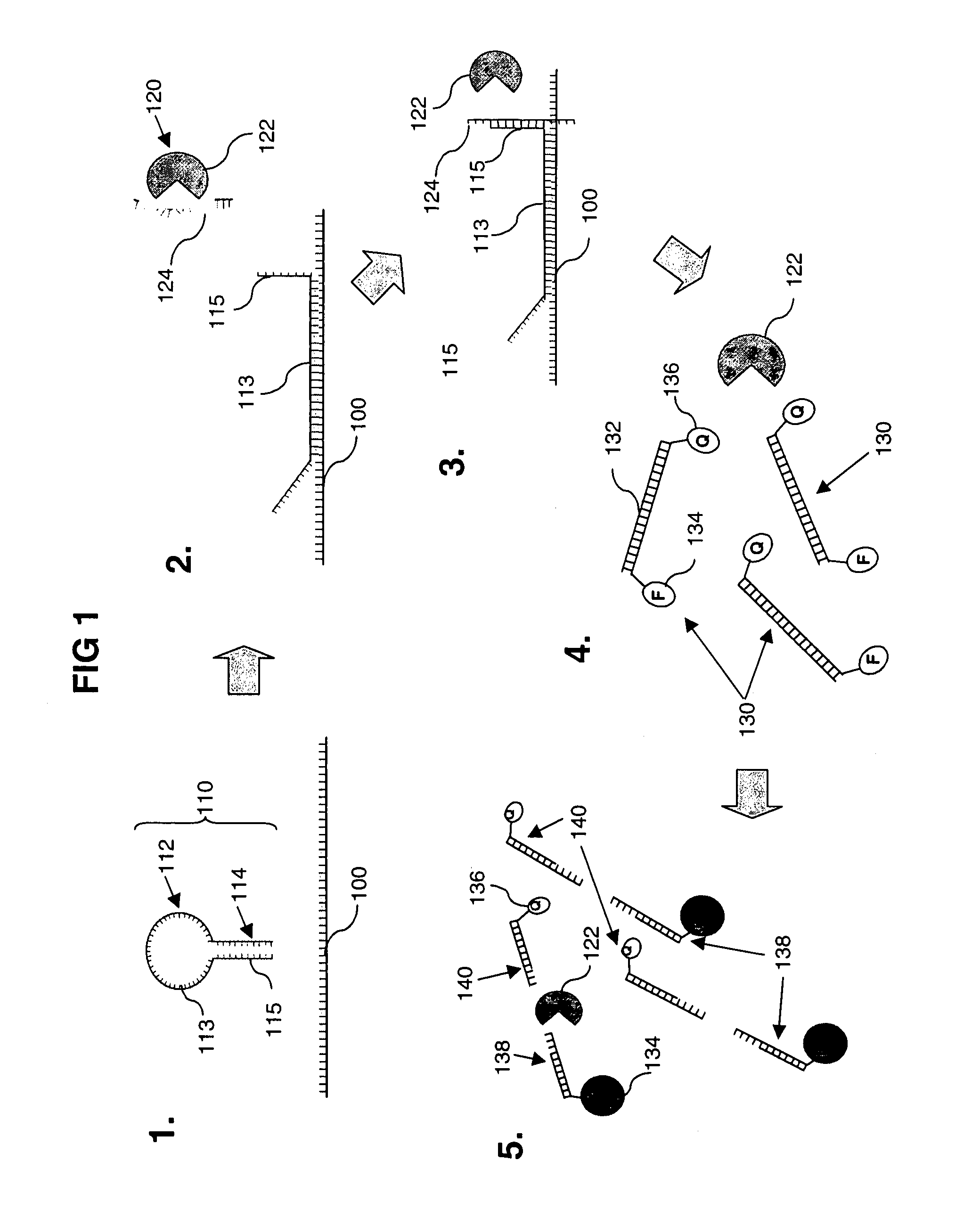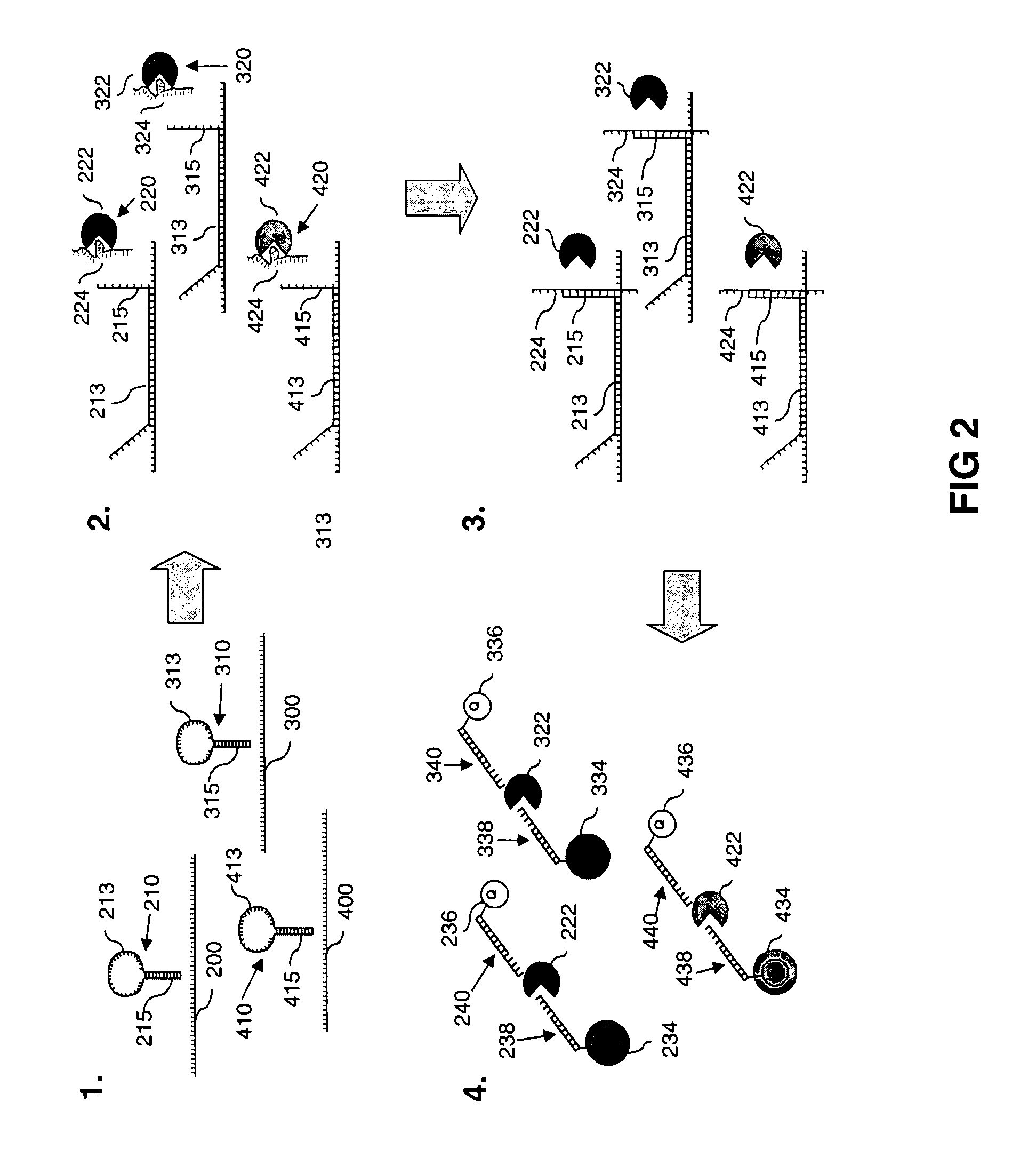Methods for detecting a target nucleotide sequence in a sample utilising a nuclease-aptamer complex
a nuclease and complex technology, applied in the field of methods for detecting a target nucleotide sequence in a sample, can solve the problems of high equipment requirements, time-consuming process, and high cost of equipment, and achieve the effect of reducing or eliminating binding
- Summary
- Abstract
- Description
- Claims
- Application Information
AI Technical Summary
Benefits of technology
Problems solved by technology
Method used
Image
Examples
example 1
Method for Detecting a Target Nucleotide Sequence
[0172]A method according to one embodiment of the invention will be described with respect to FIG. 1.
[0173]Panel 1 of FIG. 1 shows a target nucleotide sequence 100 and a linker nucleic acid 110 comprising a stem-loop structure. The loop-portion 112 of the stem-loop structure comprises a first nucleotide sequence 113 that can hybridise with the target nucleotide sequence 100, and the stem-portion 114 comprises a second nucleotide sequence 115 to which an aptamer can bind when the first nucleotide sequence 113 has hybridised with the target nucleotide sequence 100.
[0174]Panel 2 shows hybridisation between the first nucleotide sequence 113 in the linker nucleic acid 110, and the target nucleotide sequence 100. This hybridisation causes the stem portion 114 of the stem-loop structure to dissociate and thus expose second nucleotide sequence 115 and make it available for binding with the aptamer 124 of a nuclease-aptamer complex 120.
[0175]P...
example 2
Method for Simultaneously Detecting a Plurality of Target Nucleotide Sequences
[0178]A method according to another embodiment of the invention will be described with respect to FIG. 2.
[0179]Panel 1 of FIG. 2 shows three different target nucleotide sequences 200 / 300 / 400, and three linker nucleic acids 210 / 310 / 410, each comprising a stem-loop structure. The loop-portions of the stem-loop structures each comprise a first nucleotide sequence 213 / 313 / 413 that can hybridise with one of the specific target nucleotide sequences 200 / 300 / 400. Specifically, first nucleotide sequence 213 can specifically hybridise with target nucleotide sequence 200, first nucleotide sequence 313 can specifically hybridise with target nucleotide sequence 300 and first nucleotide sequence 413 can specifically hybridise with target nucleotide sequence 400. The stem-portions of the linker nucleic acids each comprise a second nucleotide sequence 215 / 315 / 415 to which specific aptamers can specifically bind when the f...
example 3
Biosensing Using the EcoRI-Aptamer 3_ADJ_L Complex
[0185]In one embodiment, the method of the present invention utilizes a target sequence-specific detection mechanism comprising a linker molecule that switches from an ‘inactive’ to an ‘active’ conformation upon hybridisation to a target nucleic acid. In its ‘active’ conformation, the linker is able to bind to an aptamer in complex with a restriction endonuclease, in this case: EcoRI, and release the endonuclease from aptamer-mediated inhibition. In its ‘inactive’ conformation, the linker is unable to, or has a significantly reduced ability to, interact with the endonuclease / aptamer complex. When released from inhibition, the nuclease molecule is able to cleave a signaling molecule, thus generating a detectable signal. The system is semi-quantitative, with the signal intensity proportional over a discrete range to the quantity of target nucleic acid molecules in solution.
[0186]To demonstrate that the system is applicable to real-worl...
PUM
| Property | Measurement | Unit |
|---|---|---|
| melting temperature | aaaaa | aaaaa |
| melting temperature | aaaaa | aaaaa |
| melting temperature | aaaaa | aaaaa |
Abstract
Description
Claims
Application Information
 Login to View More
Login to View More - R&D
- Intellectual Property
- Life Sciences
- Materials
- Tech Scout
- Unparalleled Data Quality
- Higher Quality Content
- 60% Fewer Hallucinations
Browse by: Latest US Patents, China's latest patents, Technical Efficacy Thesaurus, Application Domain, Technology Topic, Popular Technical Reports.
© 2025 PatSnap. All rights reserved.Legal|Privacy policy|Modern Slavery Act Transparency Statement|Sitemap|About US| Contact US: help@patsnap.com



